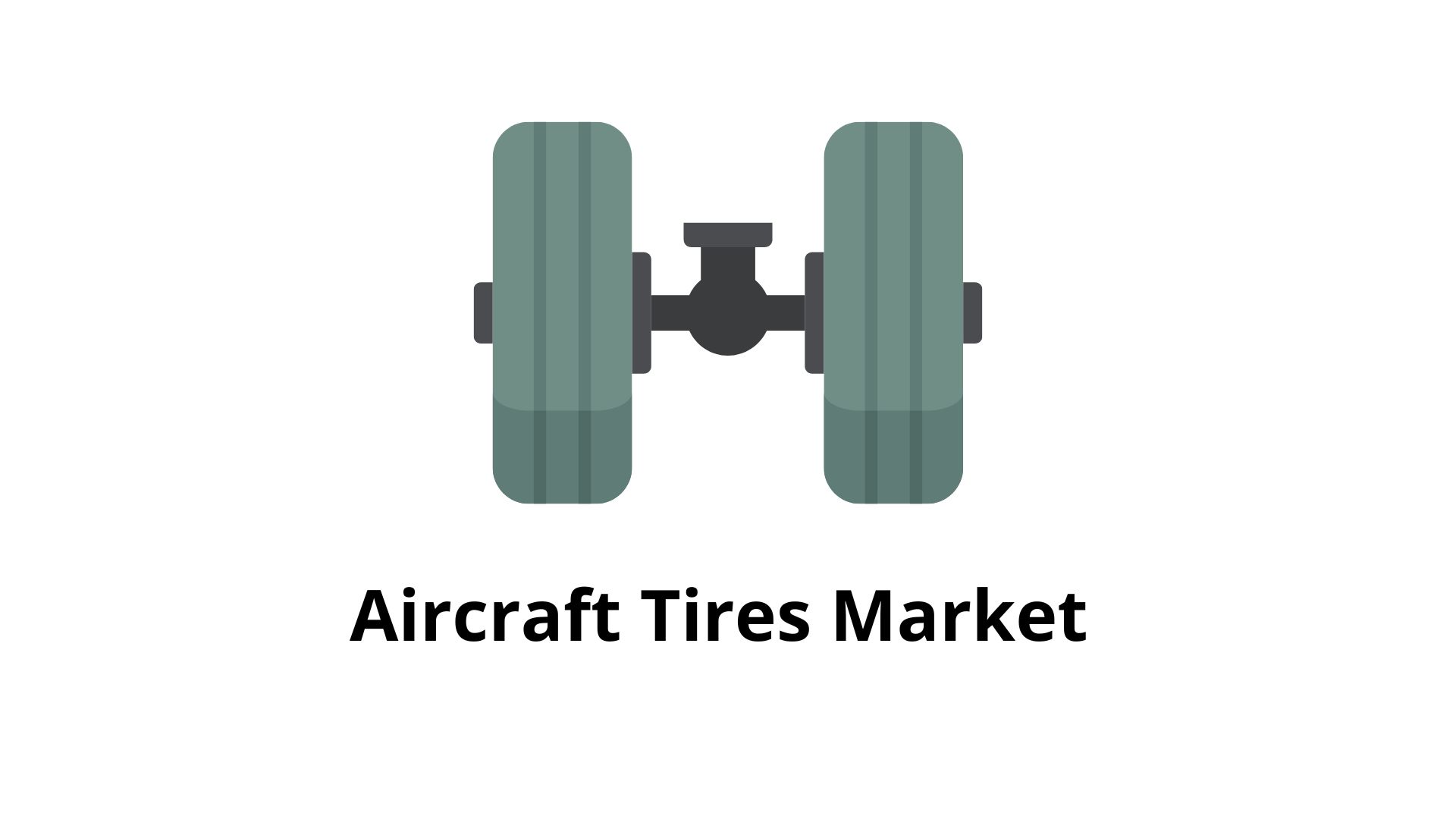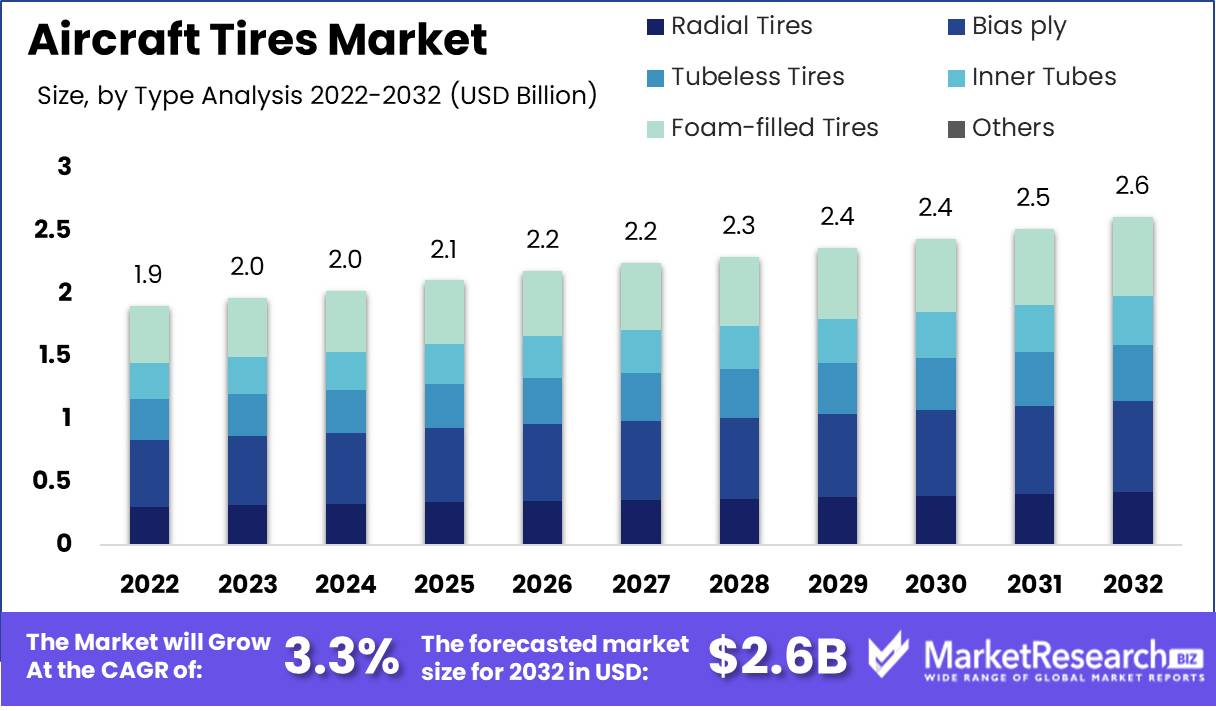Aircraft Tires Market To Rise Around USD 2.6 Bn by 2032

Page Contents
Market Overview
Published Via 11Press : Aircraft Tires Market size is expected to be worth around USD 2.6 Bn by 2032 from USD 1.9 Bn in 2022, growing at a CAGR of 3.3% during the forecast period from 2022 to 2032.
The aircraft tires market is experiencing sustained growth as an integral component of aviation. These specialized tires are tailored specifically for aviation's demanding environment – high speeds, heavy loads, and extreme conditions are just some of the special requirements that need to be met by aircraft tires. Market growth can primarily be attributed to increasing air passenger traffic levels, fleet expansion plans, replacement tire purchases and upgrades being needed as well as general market expansion.
Air passenger traffic growth has had a profound impact on the aircraft tires market. More people are opting to fly due to improving living standards, rising middle-class populations and affordability concerns; as a result, aircraft orders have increased leading to greater tire demand.
Airline fleet expansion and new aircraft model introduction has also contributed to market expansion. Airlines are constantly upgrading their fleets with more fuel-efficient aircraft to increase operational efficiencies and cut costs; modern aircraft require advanced tires which offer improved performance, fuel efficiency, and longer service lives – driving increased tire demand.
Low-cost carriers (LCCs) have had a major influence in driving market expansion. Thanks to their affordable fares and broad customer appeal, these LCCs have gained prominence and drawn newcomers into their fold. These airlines often operate short-haul flights with high aircraft utilization rates that require frequent tire replacements – driving demand for aircraft tires further.
Safety and compliance with regulatory compliance are major market influences. Aircraft tires undergo stringent testing procedures to verify their performance and reliability; strict safety regulations mandated by aviation authorities drive demand for technologically advanced, durable, and reliable aircraft tires.
Request Sample Copy of Aircraft Tires Market Report at: https://marketresearch.biz/report/aircraft-tires-market/request-sample
Key Takeaways
- The aircraft tires market has experienced steady expansion due to factors like rising passenger air travel numbers, fleet expansion, and tire replacement and upgrades.
- Global air passenger traffic growth, driven by rising living standards and affordability issues, has resulted in increased aircraft orders and tire demand.
- Airline fleet expansion and new aircraft model introduction have spurred market expansion as more advanced tires are necessary to meet the performance, fuel efficiency and longevity requirements of modern aircraft.
- Low-cost carriers (LCCs) have played an instrumental role in expanding the market, operating short-haul flights that necessitate regular tire replacements.
- Safety and regulatory compliance are the driving forces of the aircraft tire market, with strict guidelines mandating the use of technologically advanced, durable, and reliable tires.
- Fluctuating raw material prices, particularly rubber, can have serious ramifications on production costs and profitability for tire manufacturers in the aircraft tires market.
- The COVID-19 pandemic had an immediate detrimental impact on the aviation industry, reducing air travel demand and orders while having a ripple effect on aircraft tire market sales. However, as aviation recovers over time this market should regain strength.
- Technological advances in tire production should drive growth in the aircraft tire market, offering increased performance, fuel efficiency and longer service lives.
- Though there may be challenges in the aircraft tire market, its long-term prospects remain bright due to an anticipated recovery in aviation industry activity and rising air travel demand, as well as ongoing replacement and upgrade needs for aircraft tires.
Regional Snapshot
North American region, particularly the United States, accounts for an impressive share of the aircraft tire market. Major aircraft manufacturers, a robust airline industry and large fleet sizes contribute to its expansion. Furthermore, this region places a strong emphasis on technological advancements and safety compliance measures which fuel demand for high-quality tires.
Europe is another prominent market for aircraft tires. Home to several leading aircraft manufacturers like Airbus and with an established aviation industry. Stringent safety regulations and a growing emphasis on sustainable aviation have caused demand for technologically advanced yet eco-friendly aircraft tires to increase. Furthermore, low-cost carriers continue expanding across Europe further driving demand in this market.
Asia Pacific's aircraft tire market is experiencing steady expansion. Rising middle-class populations, rising disposable income levels and expanding air travel demand are driving this growth in countries like China, India and Southeast Asian nations such as Vietnam. Rapid fleet expansion due to low-cost carriers' expansion and tourism is fuelling this expansion; demand for technologically advanced and fuel-efficient aircraft tires is on the rise throughout this region.
The Middle East is an invaluable market for aircraft tire industry growth. A strategic geographical location makes the Middle East an attractive hub for major airlines, and its robust air traffic has resulted in significant infrastructure development such as airport expansions and the establishment of new airlines; all these factors increase demand for aircraft tires in this region. Meanwhile, Africa holds significant promise due to increasing air travel demand as well as investments in aviation sector growth opportunities.
For any inquiries, Speak to our expert at: https://marketresearch.biz/report/aircraft-tires-market/#inquiry
Drivers
Increased Air Passenger Traffic
With increasing international travel due to improved living standards and affordability, global airline passenger numbers continue to surge upward, driving increased aircraft orders that demand tires at greater rates than before. This demand, in turn, leads to more passenger flights that demand tires for use on board aircraft orders and then creates even greater demand.
Fleet expansion and aircraft upgrades
As airlines expand their fleets and add new aircraft models, advanced tires that offer superior performance, fuel efficiency and service life are required to increase operational efficiency while simultaneously cutting costs; hence the demand for aircraft tires continues.
Low-Cost Carriers (LCCs)
LCCs have gained widespread acclaim due to their more affordable fares, drawing in customers. Operating short-haul flights at high aircraft utilization rates requires frequent tire replacements resulting in increasing aircraft tire demand.
Safety and Regulatory Compliance
Strict regulations set forth by aviation authorities create the need for technologically advanced, durable, and reliable aircraft tires that comply with safety requirements and requirements in aviation. Focusing on compliance drives demand for high-quality tires able to stand up against aviation's demanding needs is also vital for success in this industry.
Restraints
Fluctuating raw material prices
Fluctuations in raw material prices, particularly rubber, can negatively impact production costs and profitability for tire manufacturers. Volatile raw material costs can make maintaining stable pricing margins difficult for aircraft tire makers.
Impact of the COVID-19 Pandemic
The COVID-19 pandemic had an immense effect on the aviation industry, leading to significant decreases in air travel demand and aircraft orders as well as fleet utilization resulting in a temporary decrease in aircraft tire market share. Recovering from such crises and increasing air travel demand is essential for sustained market expansion and market expansion.
Opportunities
Demand for fuel-efficient and eco-friendly tires
As the aviation industry increasingly emphasizes sustainability, opportunities arise for developing and adopting fuel-efficient aircraft tires. Tires that reduce both fuel consumption and carbon emissions provide growth prospects.
Emerging Market Expansion
Emerging markets across Asia Pacific and Latin America are experiencing rapid increases in air travel demand. Airport expansion, the proliferation of low-cost carriers, and increases in investment in the aviation sector in these regions all present opportunities for market expansion.
Technological Advancements in Tire Manufacturing
Ongoing advances in tire manufacturing technology are revolutionizing aircraft tire performance, durability and fuel efficiency. New tire tech provides manufacturers with opportunities to meet the ever-evolving needs of aviation industries worldwide while meeting rising demand for innovative aircraft tires.
Take a look at the PDF sample of this report: https://marketresearch.biz/report/aircraft-tires-market/request-sample
Challenges
Competition
The aircraft tire market is highly competitive, with several major players and tire manufacturers competing to secure market share. Such fierce rivalry presents manufacturers with challenges as they try to differentiate their products and maintain profitability within this crowded marketplace.
Compliance and Certifications
Aircraft tires must undergo stringent testing and certification processes in order to guarantee their performance and reliability, which can be challenging and time-consuming for manufacturers. Meeting stringent safety regulations while attaining necessary certifications may prove particularly complex and time-consuming.
Technological Advancements and Innovation
With technological innovation accelerating so rapidly within the aviation industry, tire manufacturers must constantly create and develop new tire technologies. Staying abreast of technological changes as well as investing in research and development presents tire manufacturers with unique challenges in meeting market needs.
Market Segmentation
By Type Analysis
- Radial Tires
- Bias ply
- Tubeless Tires
- Inner Tubes
- Foam-filled Tires
- Others
Application Analysis
- Commercial Aircraft
- Regional Aircraft
- Business Jets
- Military Aircraft
- Cargo Aircraft
- Helicopters
- Others
Distribution channel
- Original Equipment Manufacturer (OEM) Distribution
- Aftermarket Distribution
- Online Retailers
- Aircraft Tire Distributors
- Aircraft Maintenance, Repair, and Overhaul (MRO) Providers
- Aviation Supply Chain Distributors
- Tire Wholesalers and Retailers
- Other
By Platform
- Rotary Wing
- Fixed Wing
Key Players
- Goodyear Tire & Rubber Company
- Bridgestone Corporation
- Michelin
- Dunlop Aircraft Tyres Ltd.
- Wilkerson Company Inc.
- Desser Tire & Rubber Co.
- Petlas Tire Corporation
- Qingdao Sentury Tire
- Aviation Tires & Treads
- Specialty Tires of America Inc
Report Scope
| Report Attribute | Details |
| Market size value in 2022 | USD 1.9 Bn |
| Revenue Forecast by 2032 | USD 2.6 Bn |
| Growth Rate | CAGR Of 3.3% |
| Regions Covered | North America, Europe, Asia Pacific, Latin America, and Middle East & Africa, and Rest of the World |
| Historical Years | 2017-2022 |
| Base Year | 2022 |
| Estimated Year | 2023 |
| Short-Term Projection Year | 2028 |
| Long-Term Projected Year | 2032 |
Request Customization Of The Report: https://marketresearch.biz/report/aircraft-tires-market/#request-for-customization
Recent Developments
- In July 2022, Bridgestone Corporation announced that it would consolidate airplane tire manufacturing in APAC. In order to maximize efficiency in the production of aviation tires in Asian countries, where demand is significantly larger, the business is in the process of consolidating its BAA manufacturing site in Chonburi, Thailand.
- In June 2022, Japan Airlines and Bridgestone Corporation established a partnership to improve aircraft tire management and maintenance plans using tire wear prediction technologies.
- In October 2020, The Goodyear Tire & Rubber Company added KADEX Aero Supply as an aviation distributor.
FAQ
1. What materials do aircraft tires consist of
A. Aircraft tires are typically composed of both natural rubber and synthetic rubber compounds, in addition to various reinforcing materials such as steel cords or fabric layers for strength and durability.
2. How often are aircraft tires replaced
A. Replacement frequency of aircraft tires depends on various factors, including aircraft type, use patterns and maintenance practices. Tires should typically be replaced according to wear limits, damage or as per manufacturer recommendations for service life.
3. What impact does tire wear have on aircraft performance
A. Excessive tire wear can adversely impact aircraft performance, leading to reduced braking efficiency, decreased traction and increased fuel consumption. Therefore, regular monitoring and timely replacement of worn-out tires are vital in order to preserve optimal aircraft performance.
4. Are aircraft tires tubeless or tube-type
A. Modern aircraft tires typically use tubeless designs, meaning that they do not rely on an inner tube to hold air. Tubeless tires offer numerous benefits including reduced weight, better heat dissipation and enhanced puncture resistance; however, some older aircraft models still rely on traditional tube tires.
5. How are aircraft tires inflated
A. Aircraft tires are commonly inflated using compressed air from ground support equipment like tire carts or portable air compressors, providing the required air pressure. Correct inflation is vital to ensuring safe and optimal tire performance.
6. How are aircraft tires different than car tires
A. Aircraft tires differ significantly from car tires in several aspects. Aircraft tires are much larger, designed to withstand higher speeds, heavier loads, and challenging operating conditions than car tires, as well as offering greater heat dissipation capabilities and superior braking performance with resistance against debris on runways.
7. What is Retreading of Aircraft Tires
A. Retreading is a process in which the worn-out tread of an aircraft tire is removed and replaced with new layers. Retreading can extend tire lifespan while simultaneously cutting costs; however, specific guidelines and inspections must be met in order to guarantee its safety and reliability.
Contact us
Contact Person: Mr. Lawrence John
Marketresearch.Biz
Tel: +1 (347) 796-4335
Send Email: [email protected]
Content has been published via 11press. for more details please contact at [email protected]
The team behind market.us, marketresearch.biz, market.biz and more. Our purpose is to keep our customers ahead of the game with regard to the markets. They may fluctuate up or down, but we will help you to stay ahead of the curve in these market fluctuations. Our consistent growth and ability to deliver in-depth analyses and market insight has engaged genuine market players. They have faith in us to offer the data and information they require to make balanced and decisive marketing decisions.




